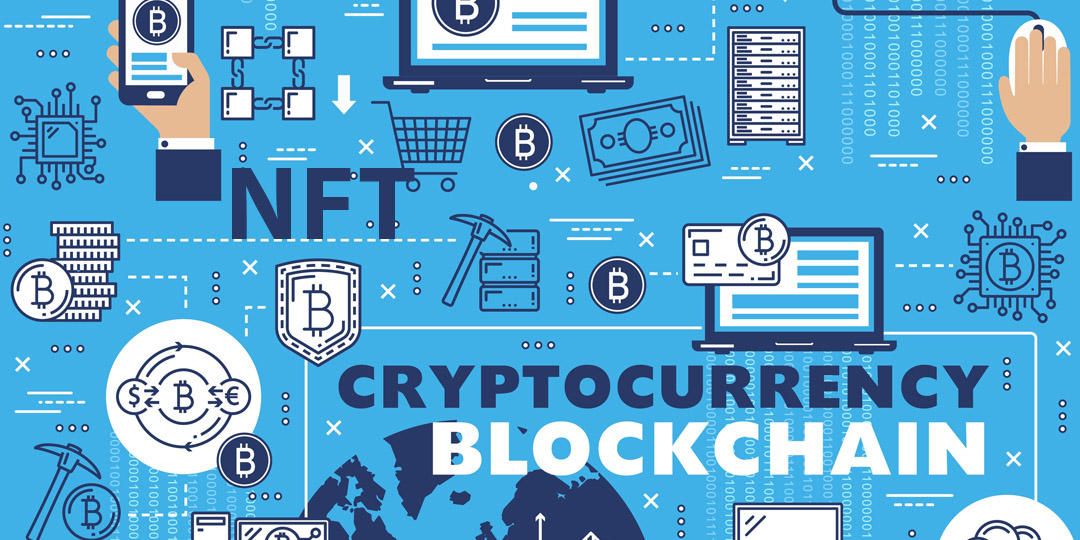NON-FUNGIBLE TOKENS & INTELLECTUAL PROPERTY RIGHTS – AN ANALYSIS

By RAKSHANA. M. K., Associate, Intellectual Property Practice
Introduction:
Non-Fungible Tokens (NFT) have been the talk of the investment world and among the Crypto community in the recent times. Over the last decade, terms such as Blockchain technology, Cryptocurrency and Non-Fungible Tokens have gained popularity among the public in this digital era. As far as NFT is concerned, the platform has planted the confidence of generating revenue both for the creators and the purchasers involved in the process. There are huge speculations in relation to Blockchain technology being the ‘next big thing’ and its ability to revolutionize the future. Cryptos and NFTs being branches of Blockchain are also expected to do the same. Scholars also speculate that this technology would play an important role in the field of Intellectual Property Rights and it is stated that Blockchain could potentially serve as a technology driven mechanism in the future which can be used as a platform that benefits the users in various manners. For instance, there shall be a technology driven smarter registry in the future which ensures smoother and time effective functioning, shall enable the owners of the IP to get royalties from those who use their creations and inventions using smart contracts, etc. The credit for development of today’s massive investment token – the NFT, goes to this technology which enables the tokenization of assets irrespective of its nature. The transactions involving digital assets in token form can be differentiated simply into two categories – The Fungible ones and The Non- Fungible ones. In simple terms, any token that contains unique attributes and that cannot be substituted for another token falls under the category of NFT. In contra, any token that can be exchanged for another one, which carries a value that shall be substituted by another token can be termed as Fungible one[i]. To understand the difference, any token carrying the value of Rs. 10 shall be purchased by exchanging 2 tokens carrying the value of Rs. 5 each. The same is impossible in the case of NFTs, the main reason being the particular token containing non-exchangeable attributes that differentiates itself from the rest of the tokens.
The Process:
The process of creating a particular Non-Fungible Token involves identification of a potential asset that shall be digitalized, following which the same shall be minted. The standards of minting the same are based on the blockchian technology used in the creation and several platforms are available which allow holders of the asset to tokenize the same. Once such minting takes place, the owner of the NFT shall be provided with an authenticity certificate, which helps to differentiate between the original version and the copy/ counterfeit of the same. Further, any party who purchases such NFT shall enter into a smart contract with the owner/ seller which is a virtual document containing the details in relation to the token, the rights that are granted to the buyer of the NFT, etc. Once a token is minted, the same shall be put up for sale and the creator chooses how he wants to sell his token. Just like the sale of any physical asset using online platform, the sale of NFTs also include options such as Fixed Price Sale, Unlimited and Timed Auction[ii]. Using the Fixed Price Sale option the creator of the NFT shall set a price for his token which shall be instantly purchased. Whereas in the case of Unlimited Auction, purchasers will be allowed to make bids until the creator accepts one. Similarly, Timed Auction also allows purchasers to make bids, but for a limited time within which the creator is bound to settle for a particular amount.
Moving on to the actual question in the plot, what do you own by purchasing an NFT? Do you own the Intellectual Properties of the particular token? Do you become the holder of the IPs involved in the NFT? Can you hold a person accountable if he infringes the IP of the actual content in the token?
The concept of NFTs have been flowing in the internet since 2012, but the consideration of the same as a potential investment tool began only in 2017, after Dapper Labs announced the digital sale of its cartoon cat character Crypto Kitties[iii]. The company announced that purchasers would be allowed to trade virtual cats and kittens, which stormed the internet and the event also proved that there were potential investors who were ready to trade upon virtual goods. Since the first sale of these tokens, the question as to what the purchaser owns once he buys a token has been bombing among the purchasing community. When a person buys an NFT the amount that he’s paying (through Crypto or by any other means) is for the ownership of a token that represents an asset which is unique, which if owned by one individual cannot be held by another unless the same is sold or transferred. Does the person own the actual asset that the token has digitalized? For instance, a painting in physical form has been purchased by an individual, he owns only the physical object of the painting and the other IP rights remain with the actual and original creator of the painting. Similarly, an NFT is merely a record of ownership of the tokenized version of the asset and not the asset itself.
Presently, owing to the large number of investors, pouring in large decimals of amount into NFTs, companies have created Licenses which clearly explains what is transferred through the purchase of the NFT by the buyers and what they are restrained from. For example, the NFT License created by Drabber Labs clearly mentions that the purchaser does not own any copyrights associated with the particular asset. In other words, the purchaser owns only a form of licensed content which specifically mentions the do’s and dont’s related to the NFT as a whole.
Protection of IP in NFT:
Currently, owing to the rise of number of investors into the platform, there is also a huge rise in the creators of NFT. People have started minting NFTs out of anything and everything available before them. Who dreamt that a twitter post bearing the terms “Just setting up my twttr”[iv] would be a potential asset that could acquire digital ownership and could be minted as a token and would be purchased for 1,630.58 Ether (Crypto value) which was about a year ago worth $2.9 million. With the rise of the NFT mints, rises the concern over Protection of the IP rights associated with the particular digital form of asset. The two types of IP Protection that faces a lot of concerns over the NFT purchase and sale are Trademarks and Copyrights.
Copyrights & NFTs:
A Copyright holder has the exclusive rights over the particular work thus has the exclusive rights to mint an NFT based on their original work. Therefore what happens in the process of creating and selling the NFT is that, the particular work in digital or tokenized form would be sold without transferring the copyright of the work. Through this mechanism, the seller would be able to earn from the tokenization of the work simultaneously ensures that the buyers do not infringe on the Copyright holders rights[v]. In case there happens to be an infringement of the Copyright of the tokenized piece of work, the remedy would be similar to that of a general Copyright infringement where the owner can initiate a suit for copyright infringement and seek reliefs. But in cases where NFTs are created by individuals based on a copyrighted work which are not being created by the actual Copyright holder, the question arises if the same amounts to infringement or not. Creating an NFT based on a copyrighted work can be termed non-infringing if the particular subject matter falls under the fair use exception. That is, the subject matter of the particular NFT ought to be modified in such a manner that it has a “new expression, meaning, or message” that would fit into the “fair use doctrine”.
Trademarks & NFTs:
The basic function of trademarks is to provide the trademark holder the exclusive right to prohibit third parties from using similar or identical marks in relation to similar or identical goods or services. Presently, due to lack of governing legislations in relation to NFTs, we see a lot of tokens minted by third parties which are either identical or similar to an existing/ well- established trademark, which ultimately leads to the infringement of the holder’s trademark. Another issue with regard to the protection of trademarks from infringement and preventing the usage by NFT minters is that, NFT being a very recent development most companies have not preferred to protect their marks in classes related to virtual goods/ services, metaverse or digital commodities, which ultimately gives the minters a ground that the goods or services of adoption of the NFTs are different, thus does not amount to infringement. The other approach followed by holders of trademarks currently is that they claim infringement on the sole ground that they are well-known marks and take action against similar marks for either similar and non- similar goods or services[vi].
Again there are two perspectives of concern over protection of IP- One, the holder of IP v. The Minter of the NFT, Two, the Owner of the NFT v. The Purchaser. As far as the first scenario is concerned, these days we see a lot of parties including fashion brands, food industry leaders and media personalities approaching the Court of Law seeking protection of their Copyrights and Trademarks and to prevent the infringement of the same in relation to minting and transacting NFTs. Some of the recent cases include:
The Pulp Fiction NFT Case:
The Kill Bill director Quentin Tarantino released his NFT which was a poster/ still from his movie ‘Pulp Fiction’, for which the distributers of the film have filed a lawsuit for copyright infringement claiming that the event was not discussed with them. The rights of the film are still owned by the distributors and the director not consulting before introducing the NFT is the spark behind the Copyright Infringement lawsuit[vii]. Despite the suit Tarantino states that he intends to go ahead with the NFT sale, even though Miramax claims that it holds the rights needed to develop, market, and sell NFTs relating to the film.
Hermes v. Mason Rothschild:
Hermes has sued the NFT creator Mason Rothschild who has designed the MetaBirkins NFTs. The company claims that that the “METABIRKINS” brand infringes the company’s famous BIRKIN trademark. The brand states that mere addition of the generic prefix ‘META’ to their famous trademark BIRKIN would still cause confusion among the purchasing members thus amounts to infringement. It is also claimed that in mid-December 2021, the brand Hermes sent a Cease and Desist letter to Rothschild to take down the NFT listings following which the lawsuit was initiated[viii].
Lil Yachty v. Opulous:
Opulus, the music NFT startup has been sued by rapper Lil, accusing the company of trademark infringement for using his name and brand as part of launch communications and claims that the usage was unauthorized as he had not agreed to get involved in the venture. It is claimed that his management met with officials of Opulus, and that he had attended another virtual meeting but both the meetings were general introductory meetings and no agreement or deal terms for the artist’s involvement was reached and that after the virtual meeting there were no further communications between the parties[ix]. Presently, the rapper urges the NFT Company to restrain from infringing his trademarks and copyrighted works and restrain the defendants from the usage of the same.
Universal Music Group v. Republic Investments:
The legal battle between the two companies for the mark REPUBLIC has been ongoing since last year. UMG has requested a preliminary injunction restraining the use of the mark by the Republic Investments as it owns the label Republic. Republic investments, moved into the music space through a partnership with an NFT platform. The issue in the present case is that Universal Music group has also declared that it is going to expand its functions to NFTs and it claims that the defendant’s marks used in relation to music-related services has already created numerous instances of actual confusion, thus the same would be detrimental to the group’s functioning especially when it plans to venture into the NFT and Meta world[x].
Nike v. StockX:
Nike sued the company StockX for selling unauthorized images of Nike shoes in the form of NFTs. Nike claims that the NFTs infringe its trademarks and are likely to confuse consumers leading to an assumption that the NFTs are being created and sold by the brand itself, which ultimately leads to a loss financially and in terms of consumer base to the brand. The company has initiated the lawsuit seeking monetary damages and an order restraining the sale of the NFTs. StockX is also accused of misleading the consumers by claiming that the buyers would be able to redeem the tokens for physical versions of the shoes and Nike claims that the buyers’ doubts about the legitimacy of the NFTs have hurt Nike’s business reputation. StockX has in the latest hearing countered Nike’s claims stating that the brand had primarily misunderstood the fundamental principle of the token and that the NFTs were used only to authenticate its physical shoes and was not selling them as standalone products, which it claims to be no different than any e-commerce retailer which uses the images and descriptions of goods to sell physical product[xi].
All the above mentioned cases being recent ones are pending before the respective Courts and the same shows the direct effect on companies and brands which is a result of lack of regulatory factors to streamline NFTs and related practices especially in relation to IP. Considering the second scenario, most purchasers due to lack of understanding of the concept of NFT claim to have acquired the IP Rights of the actual asset of the token that they have purchased which are being clarified by the minters/ sellers or the IP holders of the particular subject matter to the purchasing public that they do not own anything other than the token itself.
The Meta Effect:
The Metaverse is a form of digital world which is a hub of various virtual spaces where the users can interact with each other, live and experience virtual life. Individuals can create their own avatars and can direct their virtual life the way they want. Digital goods shall be purchased for the avatars including clothes, food, accessories and everything else that would contribute to life. These items represents the same goods that are found in normal marketplaces in real life. We see a lot of industry giants entering into the Metaverse market including Nike, Walmart, NYSE, McDonalds, Monster Energy, etc. McD has filed various applications for the registration of its marks in relation to virtual goods, services and even virtual restaurants and cafes hinting its entry into virtual reality through Metaverse. The company has also applied for marks in relation to on-line actual, virtual concerts and other entertainment services within the virtual McCafe. Panera Breads is another company that has joined the list of applicants for registration of trademarks in relation to Meta. The bakery company has applied for marks in relation to trademark its downloadable, virtual food and beverage items for use in virtual worlds along with NFTs and the option to purchase goods and avail services in the virtual world to be delivered. Applications have been filed to trademark the term NYSE for usage of the mark as an NFT and the Stock Exchange is officially entering into the Crypto and NFT marketplace. The NYSE has given a statement that it has no immediate plans of launching a Crypto or NFT and also stated that it regularly considers new products and their impact on its trademarks and protects its intellectual property rights accordingly. These events shows that Metaverse is going to be ‘next big thing’ and these are not just the companies that express their interest to protect their marks in relation to Meta and the Virtual world. The beverage giant, Monster Energy has approached the USPTO for the registration of four of its trademarks to be used in Metaverse and for the purposes of NFT. The applications indicate the marks to be used for downloadable virtual goods including beverages, food, supplements, sports, gaming, music, and apparels and online market places for the purchase of the same through NFTs. The list of companies applying to protect their marks in the virtual world sees an increase every day which evidences the fact that companies are in the prep for a new line of business with Metaverse and NFTs across industries[xii]. But, here arises another question as to how Metaverse is related to NFTs and how has the platform contributed to its development?
The answer being really simple, as stated earlier Metaverse represents the virtual reality and the platform allows the custom created avatar to perform daily activities as that of real life including entertainment, education, etc. Here, the platform replaces currency with Crytos and NFTs. Purchase and trading of goods and services required to lead the virtual life in the platform can be accomplished through NFTs. Thus it is evident that both NFTs and the Metaverse have contributed to the development of each other and the smooth and effective functioning of both without each other becomes nearly impossible owing to the day to day development in both the fields.
Protection of NFTs through IP:
The actual subject matter of the NFT can be protected under Intellectual Property subject to the fact that the same ought to fulfil the requirements to be protected. For instance, the method of minting or creating the particular NFT shall be protected under Patents in case the same falls under the category of patentable subject matter. Further, the subject matter of a token shall include anything and everything including logos, books, paintings, other forms of art, images, etc. The tokenisation of these matters opens every possibility of misuse and unauthorised usage of the same thus the legitimate owners of such subject matter shall protect the same under trademarks and copyrights to curb infringement and in case of unauthorised usage provide legal and statutory relief. The same is again subject to fulfilment of eligibility to be trademarked and copyrighted provided under the specific statutes.
Conclusion:
One fact to be accepted from the analysis of the present scenario is that apart from monetisation and revenue generation, NFT contributes in developing an innovative ecosystem thus is very well necessary to enhance creativity and provide scope for monetization from the same. In this fast growing digital world, protection of works, especially innovative ones are important irrespective of the fields. Similarly, a regularisation of these NFTs and every other aspect of the digital or the virtual world is an urgent need which ought to be coded as a specific legislation. The future of NFTs speculated from its present functioning definitely shows it to be a potential game changer especially in relation to the investment sector, thus securing of one’s IP rights is the essential and sole remedy to prevent being knocked off from the market.
References:
[i] NFTs, Explained, August 18, 2021
https://www.theverge.com/22310188/nft-explainer-what-is-blockchain-crypto-art-faq
[ii] How to create an NFT: A guide to creating a non-fungible token:
https://cointelegraph.com/nonfungible-tokens-for-beginners/how-to-create-an-nft
[iii] How a cat GIF that became an NFT sold for about $690,000?- Jan 26, 2022
[iv] Twitter CEO Jack Dorsey’s First Tweet Sold for $2.9 Million as an NFT, 23 March, 2021
[v] Non-fungible tokens (NFTs) and copyright, December 2021
https://www.wipo.int/wipo_magazine/en/2021/04/article_0007.html
[vi] How trademark infringement applies to NFTs, February, 2022
https://www.npr.org/2022/02/09/1079655055/how-trademark-infringement-applies-to-nfts
[vii] Tarantino vs. Miramax — Behind the NFT ‘Pulp Fiction’ Case, November, 2021
https://www.hollywoodreporter.com/business/digital/tarantino-miramax-pulp-fiction-nft-1235052378/
[viii] Hermès International, Et Al. v. Mason Rothschild- March, 2022
https://www.mondaq.com/india/trademark/1173342/herms-international-et-al-v-mason-rothschild
[ix] Lil Yachty Sues NFT Startup Opulous for Trademark Infringement, January, 2022
[x] Republic Records sues ‘Republic’ investment platform over trademarks, November 13, 2021
[xi] StockX strikes back at Nike in NFT lawsuit, March, 2022
https://www.reuters.com/legal/litigation/stockx-strikes-back-nike-nft-lawsuit-2022-03-31/
[xii] Virtual Land, Real Deal: Why Companies Are Investing In The Metaverse, April 2022



